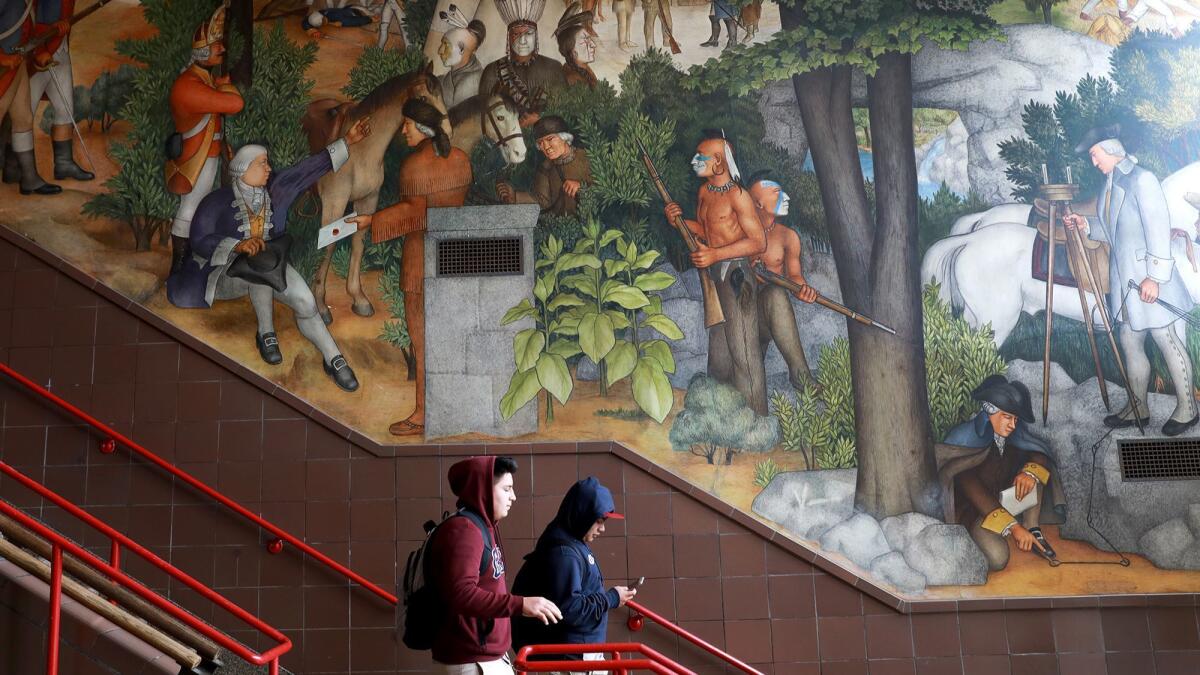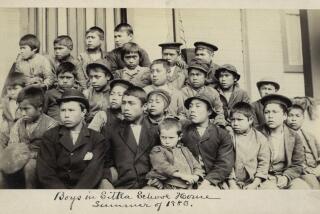School to cover up George Washington mural that depicts violence and slavery

- Share via
The San Francisco Board of Education voted unanimously this week to cover up a mural at a local high school that depicts black slaves and dead Native Americans in colonial-era scenery.
The mural at George Washington High School is the latest in a wave of public art and namesakes in California that have come under public scrutiny and have been either changed or removed. Myriad symbols have been criticized for offensive content, including racist portrayals of communities of color and symbols of colonialism in the United States.
The educational board has not yet decided how it will cover the artwork. The “Life of Washington” — which depicts slaves being sold at market and working in the fields of the president’s Mount Vernon home and the body of a dead Indian surrounded by white settlers — will either be painted over or have solid panels installed to cover it.
A spokesperson for the San Francisco Unified School District said its staff will research a timeline for painting over the mural and will report its findings in the fall, once the board reconvenes.
The decision to remove the 13-panel mural in the school’s administration building comes after the district created a community advisory committee in response to longstanding public concerns about the artwork’s content.
The group — made up of members of the local Native American community, students, school representatives, district representatives, local artists and historians — hosted public meetings between December and February as it considered options.
The mural was commissioned by the U.S. government under a New Deal-era art program in 1936 and was painted by well-known artist Victor Arnautoff, who died in 1979, educators said. It was painted using the “fresco” technique on wet plaster, meaning it’s a “permanent, integral part of the wall it was painted on.”
The advisory committee supported the removal of offensive content in the mural, the board meeting’s agenda noted. A spokesperson for the school district said a majority of the group said the main reason for wanting to keep the mural was focused on the legacy of the artist, rather than the experience of the students.
For months, community members, art historians and preservationists have argued to keep the mural. A Change.org petition created by the Russian Community Council of the USA had about 1,100 of its goal of 1,500 signatures as of Friday afternoon.
During a one-hour public comment period at the Board of Education meeting, some reiterated their objection to altering the artwork.
“The murals represent social history. They provide an inclusive and truthful history. … Removing them represents censorship as well as a reactionary moment in time,” an unidentified commenter said. “What I do recommend is that the school board establishes a multimedia display ... that indicates the complexity and contradictions of George Washington [and] the extraordinary history of Victor Arnautoff.”
The room was at capacity during the meeting, with some who signed up to speak waiting outside the room, according to an audio recording of the meeting.
Arianna Antone-Ramirez, a 2016 graduate of the district’s Galileo Academy of Science and Technology High School and part of the Tohono O’odham tribe, stressed that the cost of removing the mural would be worth it.
“Our students deserve better. We don’t need to see ourselves portrayed as dead Indians every single time we see ourselves portrayed in any type of art or in any books. We don’t need that,” Antone-Ramirez said. “We know our history already — our students don’t need to see it every single time they walk into a public school.”
More to Read
Sign up for Essential California
The most important California stories and recommendations in your inbox every morning.
You may occasionally receive promotional content from the Los Angeles Times.











